Thrusters
Summary
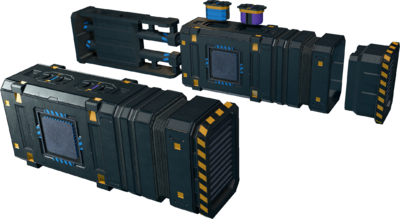
Thrusters are a mandatory part of spaceships in order for them to be able to fly. At least one thruster is required in each ship.
Use
Thrusters determine which directions spaceships can be flown and at what speed, and they require power and propellant to function.
A cable drawn from the power source must be attached to the base of the thruster for correct distribution of power.
- There are four different thruster types available:
- Plasma thrusters
- Box thrusters
- Triangle thrusters
- Maneuver thrusters
Basic information
- To be able to fly, a spaceship needs at least one thruster.
- Plasma Thrusters are the biggest thrusters so far, which can be upgraded to output more thrust. For full thrust they need a warm up time, though.
- Box and triangle thrusters are big "main" thrusters and consist of multiple parts that need to be bolted together.
- Maneuver thrusters enable small movements of the ship such as adjusting yaw and pitch, though they can still be used as main thrusters on smaller ships.
- Thrusters need to be bolted to a Hardpoint that has access to propellant and electricity.
- Thrusters need to be in the same data network as the FCU Flight control unit and MFC Main flight computer, if they are to be controled by the MFC.
- Thrusters require power to function.
- A thruster also requires propellant to function.
- To get propellant, a pipe has to be drawn between the device hardpoint and a gas container.
- Plasma Trusters will need an additional type of propellant in the future, called Karnite.
- This new fuel will come in the same containers as regular propellant does.
Thruster types
Plasma thruster
placeholder for image
Smallest possible plasma Thruster setup. plasma thrusters are build from a variety of parts.
- Box thrusters provide varrying amount of thrust depending on the amount of superconductors.
- The smallest plasma thruster setup will provide 3.5 mil thrust when cold which doubles when warmed up.
- plasma thrusters charge when their isactive field is set to 1 and lose charge if it is set to 0.
- a plasma thruster has to be fully charged in order to produce thrust.
- once the plasma thruster is fully charged it will begin to warm up, which will take 60 seconds.
- Every added superconductor ring will provide an additional 3.5 mil thrust cold and 7 mil warmed up.
- A plasma thruster nozzle is not required, but is needed to reach full thrust.
- At maximum thrust the base plasma thruster uses 598 propellant per second and 1,54K electricity per second.
Box thruster

Box Thrusters with regular and corner base variants.
- Box thrusters provide 500 000 thrust
- At maximum thrust Box thrusters use 41.28 propellant per second and 210 electricity per second.
Triangle thruster
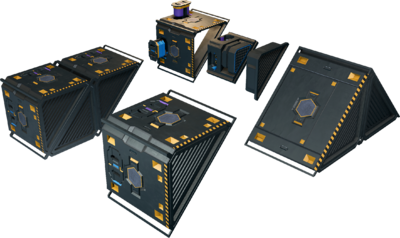
Triangle thrusters. The sides with a hexagon on them can be used to stack multiple thrusters to one base.
- Triangle thrusters provide 300 000 thrust
- At maximum thrust Triangle thrusters use 37.15 propellant per second and 96 electricity per second.
Maneuver thruster
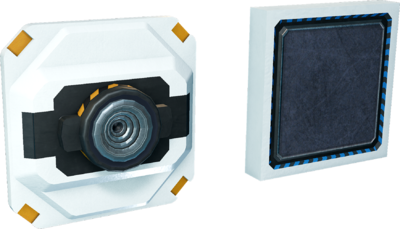
Small thrusters meant for maneuvering the ship.
- Maneuver thrusters provide 40 000 thrust
- At maximum thrust Maneuver thrusters use 23.3 propellant per second and 40 electricity per second.
Resource efficiency
Graphs showing thruster resource efficiencies per thrust level, electricity per second (eps) in blue and propellant per second (pps) in orange.
Warning: Graphs are outdated since the 03.03.2021. New graphs may follow.
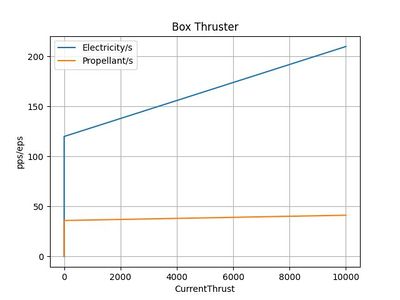
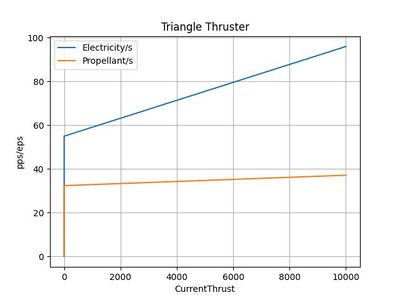
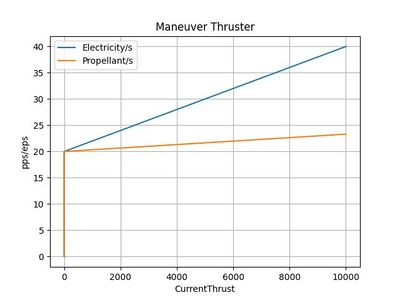
Device fields
To learn more about how to use fields, consult these wiki pages:
| YOLOL field | description | range |
|---|---|---|
| ThrusterState | Requested output of the thruster | 0 - 10 000 |
| ThrusterCurrentThrust | Current output of the thruster | 0 - 10 000 |
in addition to the fields mentioned above, the plasma thruster has two additional fields.
| YOLOL field | description | range |
|---|---|---|
| isactive | 1 = charge ; 0 = discharge | / |
| chargelevel | the current charge level of the plasma thruster | 0 - 1 |